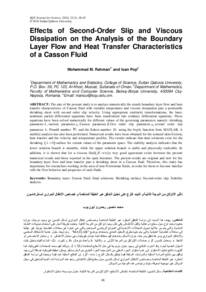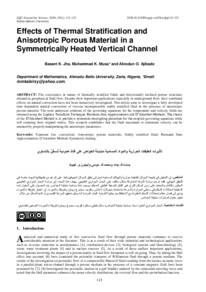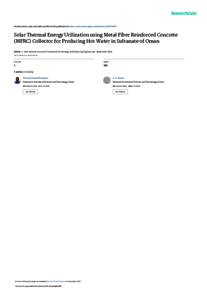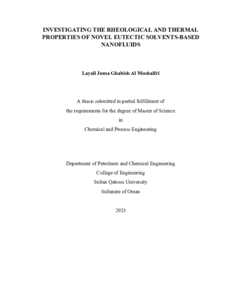Document
Hydromagnetic boundary layer flow and heat transfer characteristics of a nanofluid over an inclined stretching surface in the presence of a convective surface : a comprehensive study.
Identifier
10.24200/squjs.vol19iss2pp53-76
Source
Sultan Qaboos University Journal for Science. v. 19, no. 2, p. 53-76.
Contributors
Al-Hatmi, Mohammed M. , Author
Country
Oman.
City
Muscat.
Publisher
College of Science, Sultan Qaboos University.
Gregorian
2014
Language
English
Subject
English abstract
In this paper we investigate numerically the hydromagnetic boundary layer flow and heat transfer characteristics of a nanofluid using three types of nanoparticles (copper, aluminium oxide and titanium dioxide) having various shapes (spherical, cylindrical, arbitrary, etc) by considering three kinds of base fluids (water, ethylene glycol and engine oil) over a nonlinear inclined stretching surface, taking into account the effect of convective surface condition. Using similarity transformations, the governing nonlinear partial differential equations of the physical model are transformed into non-dimensional ordinary differential equations which are solved for local similar solutions using the very robust computer algebra software, Maple 13. The numerical simulation is carried out to investigate the role of the pertinent parameters on the flow and temperature fields as well as on the rate of heat transfer and on the rate of shear stress. The results show that the addition of nanoparticles to the base fluid may not always increase the rate of heat transfer. It depends significantly on the surface convection, type of base fluid and nanoparticles. The finding of this study will open a gate for better understanding of nanofluid characteristics.
ISSN
2414-536 X
Arabic abstract
في هذه الورقة، ندرس عددياً خصائص تدفق الطبقة الحدودية الهيدرومغناطيسية وانتقال الحرارة لسائل نانوي باستخدام ثلاثة أنواع من الجسيمات النانوية (النحاس، وأكسيد الألومنيوم، وثاني أكسيد التيتانيوم) بأشكال مختلفة (كروية، أسطوانية، عشوائية، إلخ)، وذلك بدراسة ثلاثة أنواع من السوائل الأساسية (الماء، جلايكول الإيثيلين، وزيت المحرك) على سطح تمدد مائل غير خطي، مع مراعاة تأثير حالة السطح الحملي. باستخدام تحويلات التشابه، تُحوّل المعادلات التفاضلية الجزئية غير الخطية الحاكمة للنموذج الفيزيائي إلى معادلات تفاضلية عادية غير بُعدية، تُحل باستخدام برنامج Maple 13، وهو برنامج جبر حاسوبي متطور للغاية. تُجرى المحاكاة العددية لدراسة دور المعلمات ذات الصلة في مجالات التدفق ودرجة الحرارة، بالإضافة إلى معدل انتقال الحرارة ومعدل إجهاد القص. تُظهر النتائج أن إضافة الجسيمات النانوية إلى السائل الأساسي قد لا يؤدي دائماً إلى زيادة معدل انتقال الحرارة. يعتمد ذلك بشكل كبير على الحمل الحراري السطحي، ونوع السائل الأساسي، والجسيمات النانوية. ستفتح نتائج هذه الدراسة آفاقًا جديدة لفهم خصائص السوائل النانوية بشكل أفضل.
Category
Journal articles





